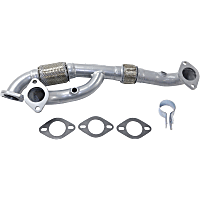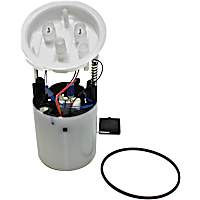Smoke from your car’s exhaust is never a good sign. A significant amount of white smoke is particularly worrisome because it almost always indicates an internal engine problem.
And that usually leads to a massive repair bill.
What Does White Smoke Coming From Your Exhaust Mean?
A wisp of white smoke from the exhaust on startup is normal. Condensation builds up in the car’s exhaust system, creating steam that looks like traces of smoke. If you live someplace that gets really cold in the winter, you’ll notice the phenomenon is even more pronounced when the temperature drops.
But plumes of white smoke coming from your car’s exhaust on a regular basis? That’s a different story. If you have white smoke coming from your exhaust when you’re accelerating, don’t ignore it.

Such a scenario almost always points to a significant problem. Here’s what might be wrong:
Blown Head Gasket(s)
Coolant entering the combustion chamber is the most common cause of white smoke. Actually, the smoke isn’t smoke at all, but rather, steam.

You’ll notice the steam usually has a sweet smell to it.
When coolant enters the combustion chamber, it’s often from a blown head gasket, which means it is no longer sealing the combustion chamber from the cooling system passages.
Head gaskets could fail due to engine overheating, oil contamination, low-octane fuel, or excessive boost in turbocharged engines. They can also fail because of poor repairs or just a lot of mileage.
Although replacing a head gasket may sound like a simple repair—it’s not. The head gasket is wedged between the engine block and cylinder head, making it difficult to access.
Expect to pay at least a couple of thousand dollars to have a professional replace your car’s head gasket(s).

Cracked Block or Cracked Cylinder Head
Do you know what’s worse than a blown head gasket? A cracked block or cracked cylinder head, that’s what. These failures allow coolant to enter the combustion chamber, much like a bad head gasket would, but they’re even more expensive to fix.
Like a blown head gasket, a cracked block or cylinder head usually results from engine overheating. So, to minimize the likelihood of these costly failures, keep an eye on your temperature gauge at all times.
Unburned Fuel Entering the Exhaust (Diesel Engines)
White smoke pouring out of the tailpipe of a diesel-powered vehicle indicates that unburned (or partially burned) fuel is entering the exhaust. The root cause of this lean condition could be anything from a faulty fuel pump to bad glow plugs.
Potential Causes of Blue-Gray or White-Gray Smoke
You’ll often hear that oil entering (and being burned inside) the combustion chamber creates blue-gray exhaust smoke. In reality, however, you may find the smoke to be gray or white in color.
Worn Valve Guides and/or Seals
One way oil can get into the combustion chamber is through worn valve guides and/or seals. Often, the issue is most noticeable upon startup and goes away quickly.
Worn Piston Rings or Cylinder Walls
If your engine’s piston rings or cylinder walls are worn, oil can sneak past the rings and into the combustion chamber. The end result is often gray-white smoke coming from your car’s tailpipe.
Positive Crankcase Ventilation (PCV) System Malfunction
An issue with the positive crankcase ventilation (PCV) system, such as a stuck PCV valve, can cause excessive oil consumption and white-gray smoke from the exhaust.
Failed Turbocharger (If Equipped)
Failed turbocharger bearings can allow oil to leak past the internal turbocharger seals, creating white smoke from the exhaust pipe.
In some cases, issues with the turbo feed and return lines can force oil past the seals as well.

What to Do if White Smoke is Coming From Your Car’s Exhaust
White smoke (not just condensation) from your car’s exhaust system indicates a serious problem that’s only going to get worse.
If you want to determine if coolant is mixing with your oil, check the engine oil dipstick. The oil should be amber, brown, black, or cream in color, depending on its condition. However, if the oil on the dipstick is foamy, it might have coolant mixed with it.
You can also check the coolant for foam. You can do this by opening the radiator and observing whether the liquid inside has bubbles. If it does, then it isn’t a good sign. Another red flag is if the coolant reservoir barely has any coolant left.
You (or your mechanic) should diagnose and repair the issue as soon as possible to prevent further damage.
Products Mentioned in this Guide
Any information provided on this Website is for informational purposes only and is not intended to replace consultation with a professional mechanic. The accuracy and timeliness of the information may change from the time of publication.


 Exhaust Pipe
Exhaust Pipe
 Piston Ring Set
Piston Ring Set
 Head Gasket Set
Head Gasket Set
 Cylinder Head Gasket
Cylinder Head Gasket
 Fuel Pump
Fuel Pump



























Thank you very much your explanation. I am running a small garage with a minimum special tools.This topic really broaden my knowledge. White smoke mostly happen to the new diesel engine with common rail technology and the maximum fuel pressure up to 1800 bar. We are waiting for the next pressure before electric car in market. Thank you. My best regards
Hi Arifin,
Thank you for the positive feedback! Is this a particular diesel vehicle you’re working on? Is so, what is the year, make, and model?
It means you need to buy an electric car!
No exhaust and no transmission among other things.
I love mine.
Get rid of the dinosaur.
Hi Theophilus,
That’s true, battery-electric vehicles do not produce any tailpipe emissions, so you don’t need to worry about white smoke!
You ev owners are not paying taxes as the people buying gas are paying taxes for the roads. The gov will catch up to this because somebody has to pay for the road work. Food for thought!
Bad diaphram in transmission modulator leaking transmission fluid into carburetor vacuum intake
Thank you.
You’re very welcome! I hope this gives you some insight as to what might be going on with your Honda.
-Mia, Chief Mechanic @ CarParts.com